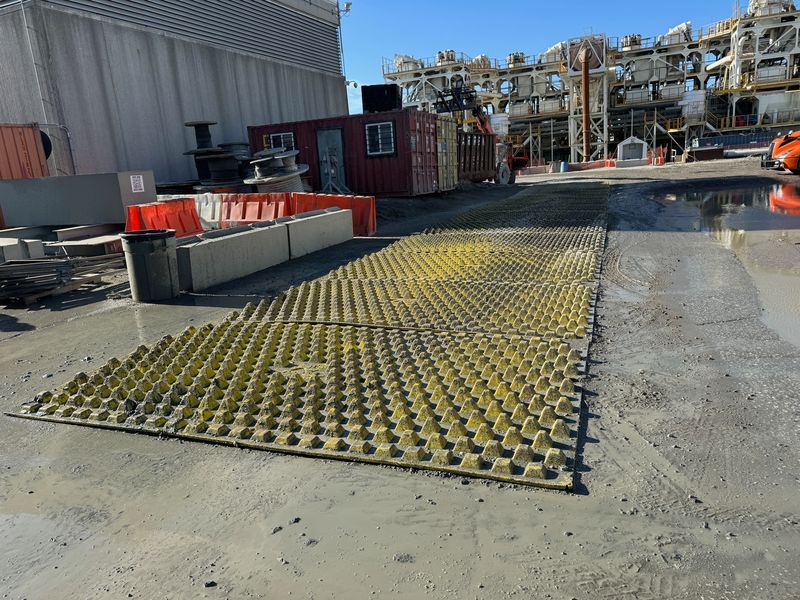Virginia Temporary Stone Construction Entrance BMP
The state of Virginia is home to a wide range of natural inland attractions, including 544 miles of the Appalachian Trail, the Blue Ridge Mountains, and the 50,000-acre John H. Kerr Reservoir. The eastern portion of the state borders the Atlantic Ocean and contains more than 7,200 miles of tidal shoreline connected to the Chesapeake Bay. Because these water resources support diverse aquatic ecosystems, Virginia places a strong emphasis on protecting the quality of surface water throughout the state.
Virginia Department of Environmental Quality & VSMP Authorities
Throughout Virginia, the Department of Environmental Quality administers the VPDES Construction General Permit program as required by the Clean Water Act. NPDES Stormwater permits regulate discharges into surface waters and require operators to manage sediment and pollution on-site. The permit program requires that operators of industrial and construction sites mitigate sedimentation and pollution on-site before contaminants reach surface water and aquatic ecosystems.
All construction sites that disturb an area of one acre or greater are regulated under the program and are required to obtain permit authorization. To obtain approval, operators must create and submit a Stormwater Pollution Prevention Plan (SWPPP) along with a Notice of Intent (NOI). The SWPPP outlines all pollution sources associated with the project and defines techniques and strategies to eliminate or mitigate their harmful effects. These techniques are called Best Management Practices (BMPs). The DEQ also publishes the Erosion and Sediment Control Handbook, which summarizes standard techniques used for common pollution sources.
The DEQ or a local authority, such as a VA Stormwater Management Program (VSMP) authority, reviews the SWPPP plans as part of the NPDES stormwater permit application process. The DEQ or VSMP is responsible for enforcing compliance with the stormwater regulation, and will regularly inspect the site to monitor the performance of various techniques and BMPs to ensure compliance with permit requirements.
Erosion and Sediment Control Handbook - Stabilized Construction Entrance
![]()
The Virginia DEQ publishes an Erosion and Sediment Control Handbook to assist contractors and industrial operators in preparing their stormwater permit applications. The handbook outlines common BMPs used throughout the state and includes specifications, application recommendations, and maintenance schedules. One of the first BMPs installed on construction projects is the Stabilized Construction Entrance, which is used to meet the requirements of Virginia Code 9VAC25-840-40 Minimum standards.
Virginia Code 9VAC25-840-40 (Minimum Standard 17) requires contractors to prevent sediment tracking onto paved public roads. If sediment is deposited, the roadway must be cleaned at the end of each day by shoveling or sweeping, with street washing allowed only after sediment is removed. These requirements apply to all land-disturbing activities, including individual development lots.
Temporary Stone Construction Entrance
The traditional technique for meeting the requirements for the Stabilized Construction Entrance is the use of a Temporary Stone Construction Entrance. A stone construction entrance consists of a stone driveway or pad at least 6 inches deep, which is underlaid with a woven filter fabric. The stone collects debris as vehicles leave the site, preventing sediment and debris from being deposited on paved roadways, which would otherwise be washed into storm drains.
The handbook specifies that #1 VDOT coarse aggregate (2" and 3" stones) is used on construction entrances. The minimum dimensions of the stone construction entrance are 70 feet in length, 12 feet in width, and 6 inches in depth. To ensure that all existing traffic uses the entrance, the width should span the entire access way. When installing the entrance, contractors should excavate a minimum of 3" down to prepare the substrate for the fabric material.
A construction entrance should be installed at all vehicular ingress and egress locations, and all construction traffic should be directed to use the entrances to prevent vehicle tracking and mud transport onto paved surfaces. This technique is only effective if all vehicles exit through the designated construction exit points.
As the construction project progresses, the entrance must be maintained to ensure effectiveness. When the rock entrance is no longer effective at mitigating sediment tracking onto roadways, the entrance must be refreshed or top-dressed with additional rock. Alternatively, the rock can be washed and reused, provided that proper drainage is used to prevent sediment from entering storm drains.
Rock Entrances and Wash Racks
![]()
If the stone-stabilized entrance is not sufficient to mitigate trackout on the project, a wash rack may be installed. A wash rack station uses pressurized water to clean debris from vehicle tires. Some wash rack stations are placed at the construction exit as a supplemental technique, while other systems are designed to serve as a stand-alone solution for vehicle trackout. Contractors installing a wash rack must ensure proper drainage of sediment-laden water to prevent clogging. In most cases, sediment traps or sediment basins are used to capture debris to prevent pollution from entering storm drains.
FODS Reusable Stabilized Construction Entrance System
FODS Trackout Control System is an effective technique to minimize vehicular sediment tracking on construction and industrial sites. The system consists of a single layer of HDPE matting, with pyramid-shaped features formed on its surface. The pyramids work to flex vehicle tire treads, allowing trapped debris to break loose. The mats are each 12' wide x 7' in the direction of travel. The system is modular and can be customized to fit the specific requirements of each project.
The system can be installed over any substrate, including asphalt, concrete, or directly on grade. The 30-minute installation process is well-suited for phased projects, including highway, pipeline, or commercial jobs, because the construction entrance can be relocated during each phase and reused multiple times. Compared to traditional techniques, the FODS system has demonstrated a 59% reduction in street sweeping at high-volume sites and is often recommended for sites that require more effective sediment-tracking control than traditional methods can provide.

The FODS Trackout Control System maintains effective performance throughout the product's life and remains unaffected by heavy traffic or rain events. The mats require maintenance when sediment builds between the pyramids. Maintaining the system involves cleaning the mats; cleaning is usually performed with a skid steer using a broom attachment or manually using a FODS shovel. The mats are designed to be used as a stand-alone BMP to mitigate vehicle tracking in place of a traditional stone-stabilized construction entrance. In most cases, a 35' extended 1x5 configuration is used as a replacement for a 70' stone construction entrance.
Together, these BMPs form an integrated approach to minimizing sediment tracking and protecting Virginia’s surface waters. Whether a project utilizes traditional stone, supplemental wash racks, or modern reusable systems, maintaining an effective stabilized construction entrance is crucial for meeting VPDES permit requirements and ensuring long-term compliance throughout each phase of construction.
Additional Resources:
DEQ ESC Handbook - Chapter 3.02
DEQ Stormwater Permit - Construction
Fairfax VSMP Stormwater Management (VSMP)
Virginia Code 9VAC25-840-40. Minimum Standards
